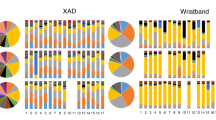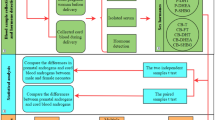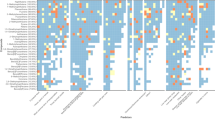Abstract
In a birth cohort study, we have assessed the dose-response relationship between individual measurements of prenatal airborne polycyclic aromatic hydrocarbon (PAH) exposure and specific PAH–DNA adducts in cord blood adjusted for maternal blood adducts and season of birth. The study uses data from an earlier established birth cohort of children in Krakow. The final analysis included 362 pregnant women who gave birth to term babies and had complete data on personal exposure in the second trimester of pregnancy to eight airborne PAHs including benzo[a]pyrene (B[a]P), as well as DNA adducts, both in maternal and cord blood. The relation between cord blood PAH–DNA adducts and airborne prenatal PAH exposure was non-linear. Although cord blood PAH–DNA adducts were significantly associated with the B[a]P exposure categorized by tertiles (non-parametric trend z=3.50, P<0.001), the relationship between B[a]P and maternal blood adducts was insignificant (z=1.63, P=0.103). Based on the multivariable linear regression model, we estimated the effect of the prenatal airborne B[a]P on the level of cord blood adducts. In total, 14.8% of cord blood adducts variance was attributed to the level of maternal adducts and 3% to a higher prenatal B[a] exposure above 5.70 ng/m3. The calculated fetal/maternal blood adduct ratio (FMR) linearly increased with B[a]P exposure (z=1.99, P=0.047) and was highest at B[a]P concentrations exceeding 5.70 ng/m3. In conclusion, the results support other findings that transplacental exposure to B[a]P from maternal inhalation produces DNA damage in the developing fetus. It also confirms the heightened fetal susceptibility to prenatal PAH exposure that should be a matter of public health concern, particularly in the highly polluted areas, because DNA adducts represent a pro-carcinogenic alteration in DNA. The continuation of this birth cohort study will assess the possible health effects of fetal DNA damage on the health of children and help in establishing new protective guidelines for newborns.
This is a preview of subscription content, access via your institution
Access options
Subscribe to this journal
Receive 6 print issues and online access
$259.00 per year
only $43.17 per issue
Buy this article
- Purchase on SpringerLink
- Instant access to full article PDF
Prices may be subject to local taxes which are calculated during checkout





Similar content being viewed by others
References
WHO. Polynuclear aromatic hydrocarbons (PAH). In. WHO Air Quality Guidelines for Europe 2nd edn World Health Organization, Regional Office for Europe Copenhagen. 2001.
Lijinsky W . The formation and occurrence of polynuclear aromatic hydrocarbons associated with food. Mutat 1991; 259: 251–261.
Phillips DH . Polycyclic aromatic hydrocarbons in the diet. Mutat Res 1999; 443: 139–147.
U.S. EPA. Supplemental guidance for assessing cancer susceptibility from early-life exposure to carcinogens. Environmental Protection Agency 2005.
IARC Monographs on the evaluation of carcinogenic risks in humans. Some Non-Heterocyclic Polycyclic Aromatic Hydrocarbons and Some Related Exposures Vol 92. Lyon, France. 2010.
Perera F, Whyatt R, Jedrychowski W, Rauh V, Manchester D, Santella RM et al A study of the effects of environmental polycyclic aromatic hydrocarbons on birth outcomes in Poland. Am J Epidemiol 1998; 147: 309–314.
Dejmek J, Solansky I, Benes I, Lenicek J, Sram RJ . The impact of polycyclic aromatic hydrocarbons and the particles on pregnancy outcome. Environ Health Perspect 2000; 108: 1159–1164.
Perera FP, Tang D, Rauh V, Lester K, Tsai WY, Tu YH et al Relationships among polycyclic aromatic hydrocarbon-DNA adducts, proximity to the World Trade Center, and effects on fetal growth. Environ Health Perspect 2005; 113: 1062–1067.
Choi H, Jedrychowski W, Spengler J, Camann DE, Whyatt RM, Rauh V et al International studies of prenatal exposure to polycyclic aromatic hydrocarbons and fetal growth. Environ Health Perspect 2006; 114: 1744–1750.
Perera FP, Rauh V, Whyatt RM, Tsai WY, Tang D, Diaz D et al Effect of prenatal exposure to airborne polycyclic aromatic hydrocarbons on neurodevelopment in the first 3 years of life among inner-city children. Environ Health Perspect 2006; 114: 1287–1292.
Perera F, Li Z, Whyatt R, Hoepner L, Wang S, Camann D et al Prenatal polycyclic aromatic hydrocarbon exposure and child intelligence at age 5. Pediatrics 2009; 124: e195–e202.
Edwards SC, Jedrychowski W, Butscher M, Camann D, Kieltyka A, Mroz E et al Prenatal exposure to air borne polycyclic aromatic hydrocarbons and children’s intelligence at 5 years of age in a prospective study in Poland. Environ Health Perspect 2010; 118: 1326–1331.
Kihlstrom I . Placental transfer of benzo(a)pyrene and its hydrophilic metabolites in the guinea pig. Acta Pharmacol Toxicol (Copenh) 1986; 58: 272–276.
Srivastava VK, Chauhan SS, Srivastava PK, Kumar V, Misra UK . Fetal translocation and metabolism of PAH obtained from coal fly ash given intra-tracheally to pregnant rats. J Toxicol Environ Health 1986; 18: 459–469.
Neubert D, Tapken S . Transfer of benzo(a)pyrene into mouse embryos and fetuses. Arch Toxicol 1988; 62: 236–239.
Schocket B . DNA damage in humans exposed to environmental and dietary polycyclic aromatic hydrocarbons. Mutat Res 1999; 8: 143–153.
Shuker DE . The enemy at the gates? DNA adducts as biomarkers of exposure to exogenous and endogenous genetoxic agents. Toxicol Lett 2002; 134: 51–56.
Perera FP, Tang D, Whyatt RM, Lederman SA, Jedrychowski W . DNA damage from polycyclic aromatic hydrocarbons measured by benzo[a]pyrene-DNA adducts in mothers and newborns from Northern Manhattan, the World Trade Center Area, Poland, and China. Cancer Epidemiol Biomarkers Prev 2005; 14: 709–714.
Schulte PA, Perera FP . Molecular Epidemiology: Principles and Practices. Academic Press San Diego, CA. 1993.
Godschalk RWL, Van Schooten FJ, Bartsch H . A critical evaluation of DNA adducts as biological markers for human exposure to polycyclic aromatic compounds. J Biochem Mol Biol 2003; 36: 1–11.
Whyatt RM, Jedrychowski W, Hemminki K, Santella RM, Tsai WY, Yang K et al Biomarkers of polycyclic aromatic hydrocarbon-DNA damage and cigarette smoke exposures in paired maternal and newborn blood samples as a measure of differential susceptibility. Cancer Epidemiol Biomarkers Prev 2001; 10: 581–588.
Anderson LM, Diwan BA, Fear NT, Roman E . Critical windows of exposure for children’s health: cancer in human epidemiological studies and neoplasms in experimental animal models. Environ Health Perspect 2001; 109: 573–594.
Perera FP, Tang D, Tu YH, Cruz LA, Borjas M, Bernert T et al Biomarkers in maternal and newborn blood indicate heightened fetal susceptibility to procarcinogenic DNA damage. Environ Health Perspect 2004; 112: 1133–1136.
Winder C, Bonon T . The genotoxicity of lead. Mutat Res 1993; 285: 117–124.
Jedrychowski W, Whyatt RM, Camman DE, Bawle UV, Peki K, Spengler JD et al Effect of prenatal PAH exposure on birth outcomes and neurocognitive development in a cohort of newborns in Poland. Study design and preliminary ambient data. Int J Occup Med Environ Health 2003; 16: 21–29.
US Environmental Protection Agency. Compendium method to-13a in compendium of methods for the determination of toxic organic compounds in ambient air 2nd edn Office of Research and Development. National Risk Management Research Laboratory. Center for Environmental Research Information Cincinnati. 1999.
Alexandrov K, Rojas M, Geneste O, Castegnaro M, Camus AM, Petruzzelli S et al An improved fluorimetric assay for dosimetry of benzo[a]pyrene diolepoxide–DNA adducts in smokers’ lung: comparisons with total bulky adducts and aryl hydrocarbon hydroxylase activity. Cancer Res 1992; 51: 6248–6253.
Kelvin EA, Edwards S, Jedrychowski W, Schleicher RL, Camann D, Tang D et al Modulation of prenatal PAH exposure on PAH-DNA adducts in cord blond by plasma antioxidants. Cancer Epidemiol Biomarkers Prev 2009; 18: 2262–2268.
Mooney LVA, Santella RM, Covey L, Jeffrey AM, Bigbee W, Randall MC et al Decline of DNA damage and other biomarkers in peripheral blood following smoking cessation. Cancer Epidemiol Biomarkers Prev 1995; 4: 627–634.
Paleologo M, van Schooten FJ, Pavanello S, Kriek E, Zordan M, Clonfero E et al Detection of benzo(a)pyrene-diol-epoxide-DNA adducts in white blood cells of psoriatic patients treated with coal tar. Mutat Res 1992; 281: 11–16.
Godschalk RWL, Feldker DE, Borm PJ, Wouters EF, van Schooten FJ . Body mass index modulates aromatic-DNA adduct levels and their persistence in smokers. Cancer Epidemiol Biomarkers Prev 2002; 11: 790–793.
Whyatt RM, Santanella RM, Jedrychowski W, Garte SJ, Bell DA, Ottman R et al Relationship between ambient air pollution and DNA damage in Polish mothers and newborns. Environ Health Perspect 1998; 106: 821–826.
Pedersen M, Wichmann J, Autrup H, Dang DA, Decordier I, Hvidberg M et al Increased micronuclei and bulky DNA adducts in cord blood after maternal exposures to traffic-related air pollution. Environ Res 2009; 109: 1012–1020.
Sram RJ, Podrazilova K, Dejmek G, Mracková G, Pilcík T . Single cell gel electrophoresis assay: sensitivity of peripheral white blood cells in human population studies. Mutagenesis 1998; 13: 99–103.
Castano-Vinyals G, D’Errico A, Malats N, Kogevinas M . Biomarkers of exposure to polycyclic aromatic hydrocarbons from environmental air pollution. Occup Environ Med 2004; 61: e12.
Perera FP, Wang S, Vishnevetsky J, Zhang B, Cole KJ, Tang D et al Polycyclic aromatic hydrocarbons-aromatic DNA adducts in cord blood and behavior scores in New York City children. Environ Health Perspect 2011; 119: 1176–1181.
Acknowledgements
The study received funding from an R01 grant entitled “Vulnerability of the Fetus/Infant to PAH, PM2.5 and ETS” (5 R01 ES10165 NIEHS; 02/01/00–01/31/04) and from the NIEHS (R01 ES010165-0451), the Lundin Foundation, the John and Wendy Neu foundation, and the Gladys T. and Roland Harriman Foundation. The principal investigator was Professor FP Perera and the co-investigator was Professor WA Jedrychowski.
Author information
Authors and Affiliations
Corresponding author
Ethics declarations
Competing interests
The authors declare no conflict of interest.
Rights and permissions
About this article
Cite this article
Jedrychowski, W., Perera, F., Tang, D. et al. The relationship between prenatal exposure to airborne polycyclic aromatic hydrocarbons (PAHs) and PAH–DNA adducts in cord blood. J Expo Sci Environ Epidemiol 23, 371–377 (2013). https://doi.org/10.1038/jes.2012.117
Received:
Accepted:
Published:
Issue date:
DOI: https://doi.org/10.1038/jes.2012.117
Keywords
This article is cited by
-
Maternal and newborn metabolomic changes associated with urinary polycyclic aromatic hydrocarbon metabolite concentrations at delivery: an untargeted approach
Metabolomics (2023)
-
Geographical approach analysis of the impact of air pollution on newborn intrauterine growth and cord blood DNA damage in Mexico City
Journal of Exposure Science & Environmental Epidemiology (2023)
-
Profiling of seasonal variation in and cancer risk assessment of benzo(a)pyrene and heavy metals in drinking water from Kirkuk city, Iraq
Environmental Science and Pollution Research (2022)
-
GSTs polymorphisms are associated with epigenetic silencing of CDKN2A gene in esophageal squamous cell carcinoma
Environmental Science and Pollution Research (2020)
-
Exposition prénatale à la pollution atmosphérique extérieure et grossesse
Revue de médecine périnatale (2017)



